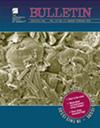扬子克拉通北部大别造山带中-中元古代(约1.37 Ga)造山岩浆活动:对哥伦比亚分裂的响应
IF 3.9
1区 地球科学
Q1 GEOSCIENCES, MULTIDISCIPLINARY
引用次数: 0
摘要
这表明扬子克拉通参与了哥伦比亚超大陆的形成和分裂。然而,由于缺乏中元古代的地质记录和可靠的古地磁资料,人们对扬子克拉通的时代、古地理位置和地质过程知之甚少。对扬子克拉通北部大别造山带新发现的中元古代石英正长岩和二长花岗岩进行了详细的地质填图、岩石学、地球化学和原位锆石U-Pb和Lu-Hf同位素研究。结果表明,石英正长岩和二长花岗岩的侵位时间分别为1369±12 Ma和1372±5 Ma。两种岩石的总碱(K2O + Na2O)和FeOt/(FeOt + MgO)含量均较高,10000 *Ga/Al比值和Zr + Nb + Ce + Y浓度均升高,轻稀土元素富集。它们还缺乏重稀土元素,具有显著的负Eu异常,但Sr, Cr和Ni含量非常低。这些成分确定了与a1型花岗岩的亲和力。石英正长岩的锆石Hf和全岩Nd同位素组成均呈变化,εHf(t)正值为+0.7 ~ +5.7(平均+2.4),εNd(t)正值为- 0.1 ~ +2.5(平均+1.0)。二长花岗岩的锆石Hf和全岩Nd同位素组成均为负,εHf(t)值为−5.7 ~−2.6(平均−4.8),εNd(t)值为−3.5 ~−1.5(平均−2.2)。石英正长岩可能是由幼体壳源性熔体部分熔融形成的,并有少量幔源性物质参与,而二长花岗岩可能是由伸展构造(如大陆裂谷)中古地壳部分熔融形成的。根据新发现的约1.37 Ga花岗质岩浆活动和已有报道的岩浆活动,我们认为扬子克拉通中-中元古代(约1.37 Ga)岩浆活动是对哥伦比亚分裂的响应,代表了扬子克拉通与哥伦比亚的分离。此外,根据比较的岩浆和沉积事件,我们认为在1.6 ~ 1.4 Ga,扬子克拉通和海南岛中部可能与Laurentia西北部、西伯利亚西南部和澳大利亚东北部相连。本文章由计算机程序翻译,如有差异,请以英文原文为准。
Mid-Mesoproterozoic (ca. 1.37 Ga) anorogenic magmatism in the Dabie orogen, northern Yangtze Craton: Response to the breakup of Columbia
It is evident that the Yangtze Craton was involved in the formation and breakup of the Columbia supercontinent. However, due to the scarcity of Mesoproterozoic geological records and reliable paleomagnetic data, little is known about the timing, paleogeographic position, and geological processes of the Yangtze Craton. We conducted detailed geological mapping, petrographic, geochemical, and in situ zircon U-Pb and Lu-Hf isotopic investigations on newly recognized Mesoproterozoic quartz syenite and monzogranite in the Dabie orogen, northern Yangtze Craton. The results show that the quartz syenite and the monzogranite were emplaced at 1369 ± 12 Ma and 1372 ± 5 Ma, respectively. Both rocks are high in total alkali (K2O + Na2O) content and FeOt/(FeOt + MgO), with elevated diagnostic 10,000*Ga/Al ratios and Zr + Nb + Ce + Y concentrations, and enrichment in light rare earth elements. They are also depleted in heavy rare earth elements with significant negative Eu anomalies but remarkably low Sr, Cr, and Ni contents. These compositions define affinity to A1-type granite. In addition, the quartz syenite displays variable zircon Hf and homogeneous whole-rock Nd isotopic compositions with positive εHf(t) values of +0.7 to +5.7 (average +2.4) and εNd(t) values of −0.1 to +2.5 (average +1.0). In contrast, the monzogranite has homogeneous zircon Hf and whole-rock Nd isotopic compositions with negative εHf(t) values of −5.7 to −2.6 (average −4.8) and εNd(t) values of −3.5 to −1.5 (average −2.2). We propose that the quartz syenite was likely generated by the partial melting of juvenile, crust-derived melt with involvement of minor mantle-derived material, while the monzogranite was likely derived from the partial melting of ancient crust in an extensional tectonic regime (e.g., continental rift). Based on the newly recognized ca. 1.37 Ga granitic magmatism and previously reported magmatic events, we argue that the mid-Mesoproterozoic (ca. 1.37 Ga) magmatism in the Yangtze Craton occurred in response to the breakup of Columbia, and represents the separation of the Yangtze Craton from Columbia. Furthermore, according to comparable magmatic and sedimentary events, we propose that the Yangtze Craton, along with central Hainan Island, may have been linked to northwestern Laurentia, southwestern Siberia, and northeastern Australia during 1.6−1.4 Ga.
求助全文
通过发布文献求助,成功后即可免费获取论文全文。
去求助
来源期刊

Geological Society of America Bulletin
地学-地球科学综合
CiteScore
9.30
自引率
8.20%
发文量
159
审稿时长
4-8 weeks
期刊介绍:
The GSA Bulletin is the Society''s premier scholarly journal, published continuously since 1890. Its first editor was William John (WJ) McGee, who was responsible for establishing much of its original style and format. Fully refereed, each bimonthly issue includes 16-20 papers focusing on the most definitive, timely, and classic-style research in all earth-science disciplines. The Bulletin welcomes most contributions that are data-rich, mature studies of broad interest (i.e., of interest to more than one sub-discipline of earth science) and of lasting, archival quality. These include (but are not limited to) studies related to tectonics, structural geology, geochemistry, geophysics, hydrogeology, marine geology, paleoclimatology, planetary geology, quaternary geology/geomorphology, sedimentary geology, stratigraphy, and volcanology. The journal is committed to further developing both the scope of its content and its international profile so that it publishes the most current earth science research that will be of wide interest to geoscientists.
 求助内容:
求助内容: 应助结果提醒方式:
应助结果提醒方式:


